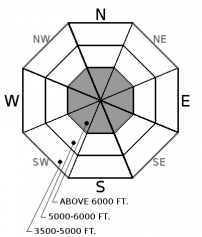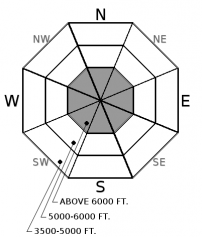| Friday | Friday Night | Saturday | |
|---|---|---|---|
| Cloud Cover: | Snow | Snow | Snow |
| Temperatures: | 25 to 30 deg. F. | 15 to 20 deg. F. | 25 to 30 deg. F. |
| Wind Direction: | SW | WSW | S |
| Wind Speed: | 10 to 15 mph, gusting 20 mph | 10 to 15 mph, gusting 20 | 5 to 10 mph |
| Snowfall: | 3 to 5 in. | 0 to 2 in. | 1 to 3 in. |
| Snow Line: |
Whitefish Range
Flathead Range and Glacier National Park
How to read the forecast
Dangerous avalanche conditions remain at upper elevations as snow and wind formed cohesive slabs stressing buried weak layers. Natural or human triggered avalanches are most likely on slopes steeper than 35 degrees at upper elevations. At mid to lower elevations, heightened avalanche conditions exist on steep slopes and gullies due to buried crust and surface hoar. Our variable and complex snowpack requires slope-specific evaluation and watch for surface cracking or audible collapses as signs of instability before skiing or riding.

3. Considerable
?
Above 6500 ft.
2. Moderate
?
5000-6500 ft.
2. Moderate
?
3500-5000 ft.
- 1. Low
- 2. Moderate
- 3. Considerable
- 4. High
- 5. Extreme
-
Type ?
-
Aspect/Elevation ?

-
Likelihood ?CertainVery LikelyLikelyPossible
 Unlikely
Unlikely -
Size ?HistoricVery LargeLargeSmall

2-4” of light snowfall yesterday and overnight added to storm slabs formed over the last few days at mid to upper elevations. These slabs formed above a surface crust (rain, rime, or sun), buried surface hoar, and/ or lower density snow. Additional snowfall today will thicken these slabs and stress buried weak layers found 1-2’ below the surface. Human triggering of storm slabs is likely today at upper elevation. Evaluate storm totals, wind-loading, and test small slopes before going into steeper terrain while anticipating thicker slabs on leeward features and gullies. Watch for cracking in new snow and avoid lens shaped pillows.
-
Type ?
-
Aspect/Elevation ?

-
Likelihood ?CertainVery LikelyLikelyPossible
 Unlikely
Unlikely -
Size ?HistoricVery LargeLargeSmall

We don’t have evidence that the loading event over the last few days reactivated persistent weak layers buried 2-5’ deep. Multiple buried rain and sun crust, weak faceted snow, and buried surface hoar remain a concern and exist on some slopes. These lurking weak layers can persist for days, week, and even months given the right conditions. Likely trigger locations are where the slab is thinnest or near rock outcrops. Watch for warning signs of instability such as shooting cracks or audible collapses. This complex problem will exist as long as our poor snowpack structure lingers. Digging is the only way to identify which slopes contain these persistent weak layers. When in doubt, stick to lower angle slopes and less consequential terrain.
-
Type ?
-
Aspect/Elevation ?

-
Likelihood ?CertainVery LikelyLikelyPossible
 Unlikely
Unlikely -
Size ?HistoricVery LargeLargeSmall

Deep slab avalanches failing near the ground or above faceted crust remain a low likelihood, high consequence concern in the Flathead and northern Whitefish Ranges. This is a difficult problem to forecast and managing terrain choices is your best weapon to avoid a very large and destructive avalanche. Deep slabs are most likely to be triggered on upper elevation slopes containing variable snow depths and rocky terrain. They can be triggered from less steep areas on adjacent slopes and below steep terrain. Snowpack assessment for deep weak layers is challenging and careful terrain selection is important.
Light snowfall totals yesterday and overnight range from 1-3”/ 0.1-0.3” SWE in Whitefish Range, 4”/ 0.7” SWE at Noisy Basin, and 2-3”/ 0.2-0.3” SWE in Flathead and southern Glacier National Park. We have limited observations of human triggered storm slabs and no reports of natural avalanches failing deeper in the snowpack after our more substantial loading event mid-week. Last night’s modest snowfall amounts most likely didn’t add the load needed to reactivate buried weak layers found throughout our snowpack on some slopes. However, a complex snowpack structure exist and persistent weak layers can linger for days, weeks, or even months given the right conditions and incremental loading.
Additional precipitation over the next 24 hours will continue to thicken storm slabs and stress a variety of buried weak layers. Observations show theses weak layers are reactive in stability test although we haven’t had immediate feedback observations from the snowpack such as natural avalanches, shooting cracks, or collapses. We remain in an active weather pattern for the foreseeable future so now is the time to step back and let the snowpack adjust to additional loading events. Conservative decision-making, cautious route-finding, and identifying terrain features of concern are essential. The mountains are not going anywhere, nor should you.
Another surge of moisture is forecasted for today and tonight with light to moderate accumulations expected along with the potential for intense snowfall rates. Currently, a stationary front is located along the US/ Canadian border while a shortwave trough is passing to our south through the Great Basin. WSW flow and light precipitation is being observed to our west and moisture will start to move into northwest Montana by late morning. As shortwave exist the intermountain west overnight, NW flow is established on the backside of the trough and an active pattern will continue throughout the weekend with off and on snow showers and generally light accumulations. We can anticipate 4-7" today and 1-3" overnight with 0.5-0.75" SWE by tomorrow morning.
This advisory applies only to backcountry areas outside established ski area boundaries. This advisory describes general avalanche conditions and local variations always occur. This advisory expires at midnight on the posted day unless otherwise noted. The information in this advisory is provided by the USDA Forest Service who is solely responsible for its content.






































